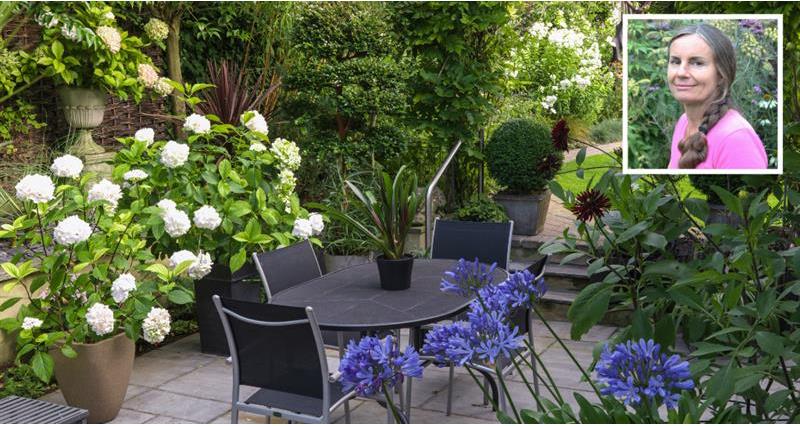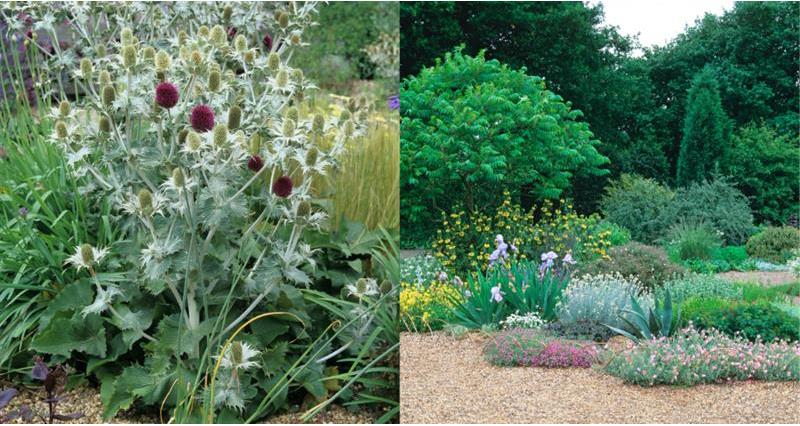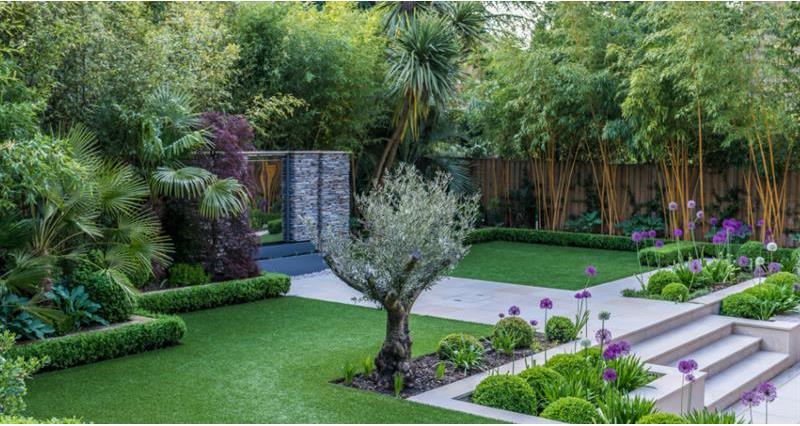From the magazine...
English gardens photographer and writer Nicola Stocken shares tips and tricks for creating a magnificent show garden without having to spend hours in your garden.

Gardens are for enjoying, whether simply chilling out with the Sunday newspapers or entertaining family and friends. But many come with a price: no garden is maintenance-free and, the more plants grown, the greater the upkeep. Fortunately, there are a number of small but simple measures which, if adopted, minimise weeding and seeding, mowing, clipping and watering, thereby adding up to a big time saving.
- Start by taking stock. Make a list of the elements of your garden that matter most – a pristine lawn, flower borders, a winter garden, a vegetable patch, trees, topiary or container planting, for example – with rough estimates of the time each takes to maintain on a monthly basis.
- Try adopting a little-and-often attitude. Regular maintenance is inevitable, and the happiest gardeners are those who are not a slave to a weekly round of chores. Keep a pair of secateurs and gardening gloves handy, so that even a brief stroll outside becomes an opportunity to dead-head the roses, or remove a few weeds there.
- Don't forget the seasonal tasks. Factor in trimming hedges, clearing up leaves and digging – as well as the annual upkeep of furniture and sheds.
Avoid the weeds
Beds and borders inevitably create work and, however deep an annual mulch in spring, some weeds will burst through. The more persistent – ground elder, bindweed, brambles and dandelions – are most effectively tackled by painting the leaves with a powerful weedkiller such as Round-up (which, once dried, is not harmful to pets). Alternatively, cut out the deep roots with a knife to gradually weaken the plant. Annual weeds are easily kept at bay with a weekly hoe.
A no-dig approach works well on soils that already have a good structure and are thoroughly rid of invasive weeds. The idea is to suppress weeds with copious amounts of compost, well-rotted farmyard manure or bark chippings, which the weather and worms slowly break down to enrich the soil with vital nutrients.
Go for gravel

Another low-maintenance option is a gravel garden, and for a wonderful example of exuberance combined with self-sufficiency, look no further than that created by the late Beth Chatto. The garden has year-round interest, provided by a backbone of easy-going, evergreen species that cope in poor soils with no irrigation – rock roses, lavender, euphorbias and Hebe pinguifolia ‘Pagei’. Then, to add spontaneity, encourage self-seeders such as hellebores, Californian poppies, allium, Stipa tenuissima, Cerinthe major ‘Purpurascens’ and Verbena bonariensis.
Originating from the dry stony soils of the Mediterranean, many drought-resistant plants thrive in gravel gardens where a layer of aggregate keeps roots cool and minimises evaporation, while also protecting from frost. A gravel mulch, laid over a permeable landscape fabric such as Groundtex Polypropylene Weed Membrane, creates a virtually weed-free border. The only drawback with a membrane is that, once in place, organic matter cannot be added to the soil, so thoroughly prepare the soil, digging in compost, before raking it level and securing the membrane in place with pegs.
Plant selection
When it comes to choosing plants, focus on frost-resistant, evergreen species, interspersed with bulbs to add a seasonal splash of colour – allium and tulips in spring; foxtail lilies and agapanthus in summer; or for autumn, schizostylus and nerines. To plant in the membrane, cut two crosswise slits, dig a hole and lower in the plant before backfilling and tucking back the membrane around the stem. Once the entire bed is planted, conceal the membrane with a seven-centimetre deep layer of gravel, adding pebbles in assorted sizes to create textural interest.
Watering can be incredibly time-consuming, so think twice about growing thirsty plants, but, if a garden without dahlias or other heavy drinkers is unthinkable, then plant close to a tap or rain butt. To conserve existing moisture, in spring dig in plenty of well-rotted manure or homemade compost and, during hot spells, mulch with compost or grass clippings.
If there are many containers, consider an automatic watering system with drippers that can be adjusted to suit individual plants and run leaky pipes through beds. However, in areas of low rainfall, it’s best not to fight nature by opting for drought-resistant, sun-lovers with grey or silver leaves that reflect the harsh rays of the sun. Among the more rewarding are evergreen Chusan palms, yuccas and phormiums, or herbaceous ice plants, Perovskia atriplicifolia ‘Blue Spire’, globe thistles and sea hollies.
No-mow area

Immaculate lawns are undeniably beautiful, but last summer’s heatwave showed just how essential watering is. In addition, there is a never-ending round of maintenance – weeding, feeding, scarifying, aerating and mowing. One alternative to large areas is to simply allow a natural lawn to establish, welcoming daisies, buttercups and clover, or even leaving an area unmown, and introducing wildflower plug plants. Natural lawns have a tousled look, rather than manicured, but can be spruced up by forming in strong circular or rectangular shapes, with sharp edges created from paving setts or flexible metal lawn edging.
Hard landscaping (pictured below), properly installed, requires little more upkeep than occasional sweeping or an annual jet-wash. To prevent weeds, install new patios or paths on impenetrable foundations, laid in either hardcore and concrete or weedproof geotextile membrane that excludes water and light. Fill cracks between paving slabs with mortar, as opposed to sand in which many plants readily germinate. When it comes to decking, steer clear of shady areas beneath trees where a build-up of leaves makes the surface slippery and more prone to rot.
Artificial turf (pictured above) is ideal for areas where pets roam or children play – it’s hypoallergenic, a boon for some hayfever sufferers. It’s also useful in places where natural grass struggles, such as deep shade, on balconies or other hard surfaces, and on contaminated ground or soil that is full of rubble. There are many suppliers now, so obtain different samples to compare quality, and ask for quotes – sloping or uneven sites may require considerable groundworks prior to installation, so factor this into the budget.
Gardening through the seasons
Each season brings some major task or another, but with good tools and planning, you can make light of tasks such as raking up fallen leaves or cutting hedges. The quickest way to collect fallen leaves is with a small leaf blower or even a vacuum shredder that collects leaves in an attached bag, ready for composting. Choosing undemanding trees is key: avoid fast-growing, unruly characters such as willows, eucalyptus or robinias, choosing instead slow-growing, compact, easily-trimmed specimen trees which include small ornamental cherries, Amelanchier lamarckii, Japanese maples or kousa dogwoods. If planting a tree in a lawn, dig a 90cm circular bed around the trunk, not only to look neat and tidy, but also to make mowing easier.
When it comes to cutting hedges, discard hand shears in favour of a trimmer – one with rechargeable batteries avoids electrical cables. For a new hedge, choose slower-growing evergreen shrubs such as box, holly or yew which, unlike vigorous privet or leylandii, need cutting just once a year.
While vintage metal furniture and lichen-encrusted wooden benches have huge charm, they attract rust and rot. Much modern garden furniture is made from synthetic materials that are UV-resistant, durable, weatherproof and, if there is limited storage, can survive outdoors all year round. The faux woven rattan look is available in stylish designs, and needs little more than a good hose down in spring.
However, the timeless appeal of wood cannot be denied, and tables crafted in hardwoods such as teak are very durable, demanding nothing more than a yearly paint with teak oil for a natural, silvered finish. As focal points, the most handsome garden buildings tend to be made from timber that has been pressure-treated to prevent rot. They do require regular treatment, but it can be minimised by painting or spraying annually with a preservative that soaks in. On the other hand, those made from plastic, resin or steel need virtually no care, but they appear rather utilitarian, and are best suited to a tucked-away spot along a side wall.
Easy-going planting

Save valuable gardening time by choosing easy-going plants that create maximum impact for minimum effort, in different seasons.
- Helleborus ‘Ashwood Garden hybrid’, an evergreen perennial that from winter until spring bears bowl-shaped white flowers with maroon speckling
- Flowering Chinese dogwood, Cornus kousa ‘Miss Satomi’, a small spreading tree that, come early summer, is smothered in rosy pink bracts
- Euphorbia characias, milkweed or spurge, an upright evergreen shrub with biennial shoots and stems of luminous green flowers from early spring
- Phormium tenax ‘Purpureum’, New Zealand flax, a robust evergreen perennial that grows fast to add structure